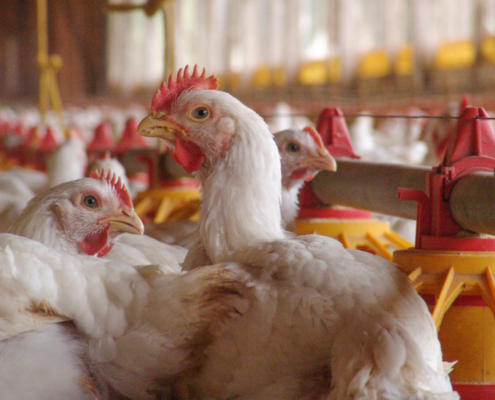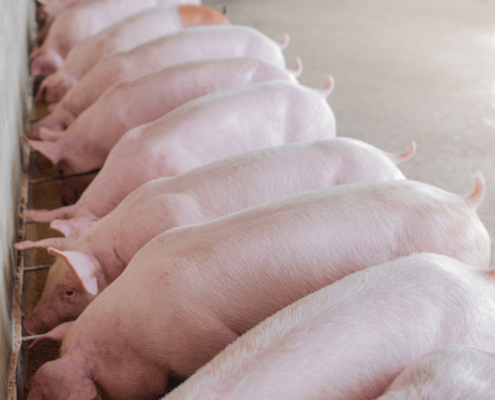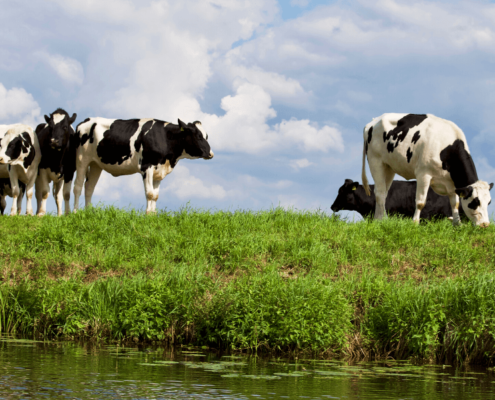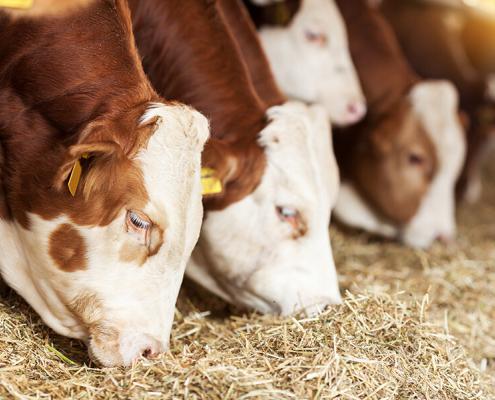Improving feed efficiency in dairy cows
Feed efficiency in dairy cows can be defined as the fraction of feed energy captured in saleable products (VandeHaar et al., 2016). It allows dairy producers to utilise their resources more effectively. This subsequently improves the profitability, sustainability, and environmental impact of their dairy business.
For many years, the Feed Conversion Ratio (FCR) has been used in the pig, poultry, and beef industries as a measure of efficiency. Within these sectors, the FCR of an animal was used as a key performance indicator (KPI) for their business and was closely associated with the profitability of that production system. However, the dairy industry has been much slower to incorporate feed efficiency measurements when analysing the success of their production systems.
Therefore, understanding the different measurements of efficiency and understanding how to improve such efficiency measurements will be of increased importance. Milk production efficiency or dairy efficiency is defined as kg’s of energy or milk butterfat corrected milk produced per kg of dry matter intake (DMI) consumed by dairy cows.
Some of the main factors that influence feed efficiency in dairy cows are:
- genetics
- stage of lactation
- health status
- nutrition
Feed efficiency boosts dairy sustainability
Despite the lack of uptake in feed efficiency measurements at farm level, feed efficiency in dairy cattle is important. Increased feed efficiency results in reduced greenhouse gas emissions (Knapp et al., 2014). A study by Capper et al. (2009) reported a 60% reduction in greenhouse gas emissions per unit of milk produced on US dairy farms over the past 60 years. Most of this reduction is coming from increased feed efficiency.
Improvements in feed efficiency will lead to less land and resources required for feed production (von Keyserlingk et al., 2013). This is important in the context of a growing human population as less land will be available for growing feed for dairy cows. Increasing output of usable products from each unit of feed input will result in less nutrients being wasted or excreted out of the dairy cow. This will have benefits in a dairy industry that may face tougher environmental constraints around manure storage and spreading on land. Finally, with feed costs cited as one of the most significant costs in dairy production, improvements in feed efficiency will have direct effects on farm profitability through a reduction in feed required per unit of output.
Dry Matter Intake vs. Feed Efficiency in dairy cows
More specifically to diet, the digestion system of a dairy cow plays a huge role in determining the level of feed efficiency achieved. The rumen is central to this digestion process. The ruminal inhabitants (microbial population) have a large influence on how nutrients are extracted from a particular feedstuff and converted into metabolic fuels for the dairy cow.
Traditionally, dairy nutritionists have emphasised on maximising dry matter intake (DMI) in dairy cows as a way of increasing milk production. However, increasing DMI may not always result in favourable productive outcomes. The “law of diminishing returns” may kick in and subsequently, nutrient digestibility decreases with increasing DMI.
As DMI increases, the feedstuffs spend less time in the rumen being digested by the rumen microbial population. Hence, less nutrients are utilised from the feed so more nutrients pass through to the lower digestive tract and are excreted out of the dairy cow. Changes in the rumen microbial population also have a big impact on the efficiency of rumen digestion.
Maintaining a stable environment for the rumen microbial populations by minimising changes in rumen pH allows starch, sugar, and fibre digesting bacteria to live in harmony digesting the range of carbohydrates consumed by the dairy cow.
Most rumen microbes are pH dependant so a daily fluctuating rumen pH will lead to the deterioration of certain bacteria and the rumen will be unable to cater for the range of carbohydrates ingested by the cow. To combat these changes in rumen pH and fluctuating rumen microbial profile, dairy cow nutritionists should ensure diets contain sufficient effective fibre and limit the amount of starch and sugars that are included in the dairy cow’s diet.
Feed additives can also be used as effective tools in maintaining a stable rumen pH. One of the feed additives getting more attraction in recent years to enhance feed effiency and reduce the risk for rumen acidosis is Acid Buf, produced by Celtic Sea Minerals.
Video: Rumen pH and VFA production (Van Soest 1994)
CalMin ProMin Acid Buf improves feed efficiency
Research done at Georgia University in the USA in early lactation Holstein dairy cows compared 90 g/head/day
Following from the work in Georgia, researchers at Stellenbosch University in South Africa conducted an experiment comparing 90 g/head/day
The most recent work was carried out at University College Dublin in Ireland. Researchers compared 80 g/head/day
The consistent improvements in feed efficiency due to
Increasing milk production efficiency will also lead to increased margin over feed costs and subsequent improvements in farm profitability. For example, a difference of 0.1 kg’s ECM per kg DMI per day in a dairy cow yielding 35 kg of milk per day can lead to an increased margin of $0.50 per cow per day over feed costs.
Summary of Feed Efficiency outcomes in experiments using CalMin ProMin Acid Buf in dairy cow diets

Conclusions
To conclude, feed efficiency measurements will need to be embraced by dairy producers. Success can be achieved with the right approach. When balancing diets for dairy cows, it will be important to understand the conflicting nature of DMI and rumen digestion so we can promote optimum DMI as opposed to maximum DMI for high producing dairy cows. The focus on the rumen microbiome will need to be centred on creating an optimum environment for different species of microbes to leave the rumen in a position to extract nutrients from all types of carbohydrates.
Maintaining an optimum environment for these microbes can start with reducing rumen pH changes. More information about the effects of
The optimum environment for rumen microbes due to
- increased productivity per kg dry matter intake
- increased milk yield and milk solids
- healthy rumen functioning
- global agriculture sustainability goals
Related articles
 https://celticseaminerals.com/wp-content/uploads/2021/02/Transition-cow-Acid-Buf-CSM-800x600-1.png
600
800
Patricia
https://celticseaminerals.com/wp-content/uploads/2020/01/Celtic_13.png
Patricia2021-02-08 15:05:032023-03-02 13:35:35Transition Cow Management
https://celticseaminerals.com/wp-content/uploads/2021/02/Transition-cow-Acid-Buf-CSM-800x600-1.png
600
800
Patricia
https://celticseaminerals.com/wp-content/uploads/2020/01/Celtic_13.png
Patricia2021-02-08 15:05:032023-03-02 13:35:35Transition Cow Management https://celticseaminerals.com/wp-content/uploads/2020/11/CSM-CeltiMin-layers-featured-image-webpage-800x600-1.png
600
800
Patricia
https://celticseaminerals.com/wp-content/uploads/2020/01/Celtic_13.png
Patricia2020-11-03 15:41:302023-03-02 13:36:21How to prevent eggshell quality problems?
https://celticseaminerals.com/wp-content/uploads/2020/11/CSM-CeltiMin-layers-featured-image-webpage-800x600-1.png
600
800
Patricia
https://celticseaminerals.com/wp-content/uploads/2020/01/Celtic_13.png
Patricia2020-11-03 15:41:302023-03-02 13:36:21How to prevent eggshell quality problems? https://celticseaminerals.com/wp-content/uploads/2020/09/CSM-featured-image-gastric-pH-800x600px.png
600
800
Patricia
https://celticseaminerals.com/wp-content/uploads/2020/01/Celtic_13.png
Patricia2020-09-20 15:10:092023-03-02 13:36:48How gastric pH affects pig gut health
https://celticseaminerals.com/wp-content/uploads/2020/09/CSM-featured-image-gastric-pH-800x600px.png
600
800
Patricia
https://celticseaminerals.com/wp-content/uploads/2020/01/Celtic_13.png
Patricia2020-09-20 15:10:092023-03-02 13:36:48How gastric pH affects pig gut health https://celticseaminerals.com/wp-content/uploads/2020/07/CSM-featured-image-heat-stress-asia.png
600
800
Patricia
https://celticseaminerals.com/wp-content/uploads/2020/01/Celtic_13.png
Patricia2020-07-28 08:45:572023-03-02 13:38:15Heat stress in dairy cows
https://celticseaminerals.com/wp-content/uploads/2020/07/CSM-featured-image-heat-stress-asia.png
600
800
Patricia
https://celticseaminerals.com/wp-content/uploads/2020/01/Celtic_13.png
Patricia2020-07-28 08:45:572023-03-02 13:38:15Heat stress in dairy cows https://celticseaminerals.com/wp-content/uploads/2020/06/CSM-featured-image-feed-efficiency-800x600px.png
600
800
Patricia
https://celticseaminerals.com/wp-content/uploads/2020/01/Celtic_13.png
Patricia2020-06-30 12:28:302023-03-02 13:39:19Improving feed efficiency in dairy cows
https://celticseaminerals.com/wp-content/uploads/2020/06/CSM-featured-image-feed-efficiency-800x600px.png
600
800
Patricia
https://celticseaminerals.com/wp-content/uploads/2020/01/Celtic_13.png
Patricia2020-06-30 12:28:302023-03-02 13:39:19Improving feed efficiency in dairy cows https://celticseaminerals.com/wp-content/uploads/2020/06/CSM-featured-image-piglets-sleeping-800x600px.png
600
800
Patricia
https://celticseaminerals.com/wp-content/uploads/2020/01/Celtic_13.png
Patricia2020-06-23 15:33:152023-03-02 13:40:54How to reduce pig aggression?
https://celticseaminerals.com/wp-content/uploads/2020/06/CSM-featured-image-piglets-sleeping-800x600px.png
600
800
Patricia
https://celticseaminerals.com/wp-content/uploads/2020/01/Celtic_13.png
Patricia2020-06-23 15:33:152023-03-02 13:40:54How to reduce pig aggression? https://celticseaminerals.com/wp-content/uploads/2020/06/CSM-featured-image-beef-cattle-charolais-800x600px.png
600
800
Patricia
https://celticseaminerals.com/wp-content/uploads/2020/01/Celtic_13.png
Patricia2020-06-16 07:25:322023-03-02 13:41:17Fiber digestion drives beef cattle performance
https://celticseaminerals.com/wp-content/uploads/2020/06/CSM-featured-image-beef-cattle-charolais-800x600px.png
600
800
Patricia
https://celticseaminerals.com/wp-content/uploads/2020/01/Celtic_13.png
Patricia2020-06-16 07:25:322023-03-02 13:41:17Fiber digestion drives beef cattle performance Celtic Sea Minerals
https://celticseaminerals.com/wp-content/uploads/2020/06/CSM-featured-image-dairy-cow-neville-800x600px.png
600
800
Patricia
https://celticseaminerals.com/wp-content/uploads/2020/01/Celtic_13.png
Patricia2020-06-01 20:53:282023-03-02 13:44:46How a rumen buffer drives dairy performance
Celtic Sea Minerals
https://celticseaminerals.com/wp-content/uploads/2020/06/CSM-featured-image-dairy-cow-neville-800x600px.png
600
800
Patricia
https://celticseaminerals.com/wp-content/uploads/2020/01/Celtic_13.png
Patricia2020-06-01 20:53:282023-03-02 13:44:46How a rumen buffer drives dairy performance https://celticseaminerals.com/wp-content/uploads/2020/05/CSM-featured-image-holstein-cow-gras-800x600px.png
600
800
Patricia
https://celticseaminerals.com/wp-content/uploads/2020/01/Celtic_13.png
Patricia2020-05-24 21:54:212023-03-02 13:45:11How to reduce the risk for grass staggers?
https://celticseaminerals.com/wp-content/uploads/2020/05/CSM-featured-image-holstein-cow-gras-800x600px.png
600
800
Patricia
https://celticseaminerals.com/wp-content/uploads/2020/01/Celtic_13.png
Patricia2020-05-24 21:54:212023-03-02 13:45:11How to reduce the risk for grass staggers? https://celticseaminerals.com/wp-content/uploads/2020/05/CSM-featured-image-pig-nose-800x600px.png
600
800
Patricia
https://celticseaminerals.com/wp-content/uploads/2020/01/Celtic_13.png
Patricia2020-05-12 22:21:192023-03-02 13:46:30How to prevent gastric ulcers in pigs?
https://celticseaminerals.com/wp-content/uploads/2020/05/CSM-featured-image-pig-nose-800x600px.png
600
800
Patricia
https://celticseaminerals.com/wp-content/uploads/2020/01/Celtic_13.png
Patricia2020-05-12 22:21:192023-03-02 13:46:30How to prevent gastric ulcers in pigs? Celtic Sea Minerals
https://celticseaminerals.com/wp-content/uploads/2020/04/CSM-Iceland-Marine-Minerals.png
600
800
Patricia
https://celticseaminerals.com/wp-content/uploads/2020/01/Celtic_13.png
Patricia2020-04-20 07:15:212023-03-02 13:48:33Marine Minerals Nutrition Platform
Celtic Sea Minerals
https://celticseaminerals.com/wp-content/uploads/2020/04/CSM-Iceland-Marine-Minerals.png
600
800
Patricia
https://celticseaminerals.com/wp-content/uploads/2020/01/Celtic_13.png
Patricia2020-04-20 07:15:212023-03-02 13:48:33Marine Minerals Nutrition Platform Celtic Sea Minerals
https://celticseaminerals.com/wp-content/uploads/2020/04/CSM-dairy-cow-udder-milk-fat.png
600
800
Patricia
https://celticseaminerals.com/wp-content/uploads/2020/01/Celtic_13.png
Patricia2020-04-19 18:50:522023-03-02 13:47:30How to increase butterfat in dairy cows?
Celtic Sea Minerals
https://celticseaminerals.com/wp-content/uploads/2020/04/CSM-dairy-cow-udder-milk-fat.png
600
800
Patricia
https://celticseaminerals.com/wp-content/uploads/2020/01/Celtic_13.png
Patricia2020-04-19 18:50:522023-03-02 13:47:30How to increase butterfat in dairy cows? Celtic Sea Minerals
https://celticseaminerals.com/wp-content/uploads/2020/02/koe2.jpg
600
800
Patricia
https://celticseaminerals.com/wp-content/uploads/2020/01/Celtic_13.png
Patricia2020-02-14 21:43:062023-03-02 13:47:50How to prevent rumen acidosis?
Celtic Sea Minerals
https://celticseaminerals.com/wp-content/uploads/2020/02/koe2.jpg
600
800
Patricia
https://celticseaminerals.com/wp-content/uploads/2020/01/Celtic_13.png
Patricia2020-02-14 21:43:062023-03-02 13:47:50How to prevent rumen acidosis?You want to get powered by our science?

Strand Farm
Curraghbinny
Carrigaline
Co.Cork
P43 NN62, Ireland
T: +353 21 437 8377
E: info@celticseaminerals.com
Our marine minerals are fully compliant with the following globally recognised quality assurance schemes:


![[geot country="US"] CalMin[/geot][geot country="CA"] ProMin[/geot][geot exclude_country="CA, US"] Acid Buf[/geot] improves feed efficiency and dairy sustainability [geot country="US"] CalMin[/geot][geot country="CA"] ProMin[/geot][geot exclude_country="CA, US"] Acid Buf[/geot] improves feed efficiency and dairy sustainability](https://celticseaminerals.com/wp-content/uploads/2020/06/CSM-banner-feed-efficiency-1600-x-471-px.png)
